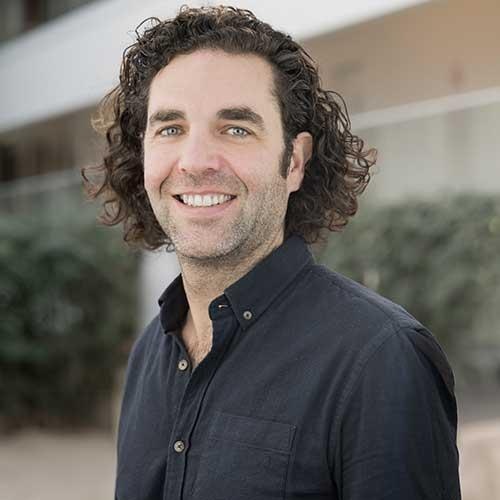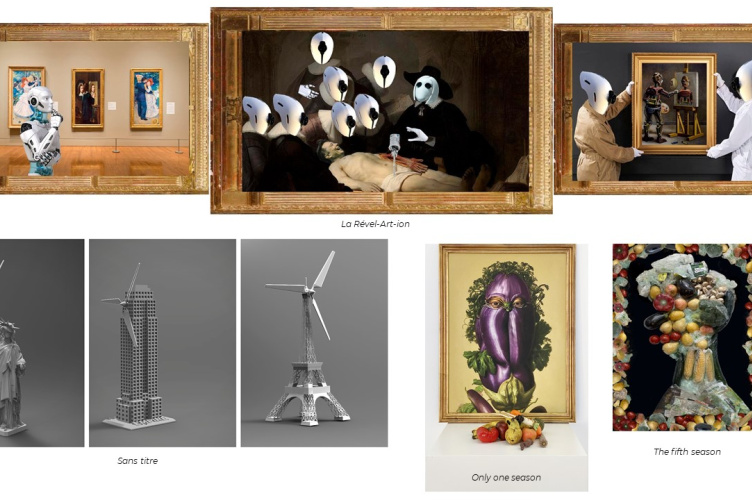A revolutionary method for innovation, leadership, and unlocking value in a volatile world—with Prof. Sylvain Bureau
In a world increasingly shaped by complexity, ambiguity and systemic upheaval, conventional business methods often struggle to deliver meaningful solutions. At the intersection of creativity, entrepreneurship and disruption, Sylvain Bureau, professor of entrepreneurship at ESCP Business School, offers a compelling alternative: Art Thinking.
A researcher, educator and co-founder of the Art Thinking Collective and the Jean-Baptiste Say Institute for Entrepreneurship, Bureau has spent more than a decade refining the Art Thinking method in collaboration with artists, executives and cultural institutions across the globe. He describes it simply as a method designed to help people create the improbable with certainty.
We spoke with him to explore how Art Thinking can help build the futures we can’t yet imagine, but urgently need.
.jpg) An Art Thinking project from an Improbable Seminar
An Art Thinking project from an Improbable Seminar What Is the Art Thinking Method?
Art Thinking invites participants to adopt an artist’s mindset to spark innovation. Rather than refining what already exists, it focuses on generating new forms of value, even in unlikely or ambiguous places. “It doesn’t aim to turn everyone into Picasso or Steve Jobs,” Bureau says, “but instead empowers individuals, even those outside traditional creative fields, to generate new value in uncertain contexts.”
While design thinking typically starts with user needs and existing problems, Art Thinking avoids what Bureau calls the “installed client.” Instead, it begins with personal values and ideological friction. “It doesn’t begin with what’s probable,” he explains. “But with personal values and ideological commitments. It is as much about inner coherence as it is about societal transformation.”
The method is structured around three core dimensions:
- Theoretical content – foundational concepts, frameworks, and case studies.
- Practical skills – honed through exercises and creative experimentation.
- Extraordinary experience – culminating in the public display of participant artworks, often in major cultural venues.
It unfolds through six steps: Donate, Deviate, Destroy, Drift, Dialogue, and Display — each designed to disrupt conventional logic. “In this context,” Bureau says, “the unknown becomes an artistic material. Art Thinking equips people with a heuristic for working with the unknown — not as a problem to solve, but as a resource to activate.”
The method has been taught in more than 15 countries, from Japan to Armenia. Participants include artists, educators, executives and organisations like Orange, KLM, BPCE, and SACEM. Its power, Bureau argues, lies in combining values, emotion, and critique — “elements all too often absent from innovation culture.”
It doesn’t aim to turn everyone into Picasso or Steve Jobs but instead empowers individuals, even those outside traditional creative fields, to generate new value in uncertain contexts.
The Improbable Seminar: breaking with convention
Art Thinking comes to life in the Improbable Seminar, where participants are invited to create and exhibit their own artwork. The goal is not technical skill, but critical reflection. “The core challenge is learning to unlearn,” Bureau says. “Many of our participants are high performers — excellent students, experts — but in a world of AI, instability, and the Anthropocene, excellence alone can lead to obsolescence.”
The core challenge is learning to unlearn. Many of our participants are high performers — excellent students, experts — but in a world of AI, instability, and the Anthropocene, excellence alone can lead to obsolescence.
 Sylvain Bureau
Sylvain BureauProfessor of entrepreneurship
ESCP Business School
The method resonates most with three groups:
- Talents – individuals with high potential, seeking to move beyond conventional excellence.
- Innovators – professionals already fluent in innovation who want to push further.
- Leaders – executives shifting from hierarchical to collaborative models, often driven by climate realities, social fragmentation or intergenerational demands.
One foundational exercise asks participants to create an artwork using three criteria: subversive critique, efficiency, and personal resonance. The effect, Bureau says, is not just cognitive but embodied: “participants shift roles, challenge their assumptions, and create something that is improbable, critical, and embodied.”
A method born at the crossroads of art and entrepreneurship
The method’s origins are, fittingly, improbable. In 2008, at a wedding, Bureau met artist Pierre Tectin and the pair found themselves deep in conversation about art, politics, and the nature of creativity. That dialogue sparked a collaboration that led to the first Art Thinking seminar — Improbable — held in 2011. Its format: no fixed syllabus, just a collective dive into uncertainty.
“We used the method itself to develop the method — an iterative, living process,” Bureau says. As the model evolved, he noticed recurring themes in successful creative work — whether in science, business or the arts: drift, critique, emotional intensity, and the willingness to act without knowing the outcome.
“It has been refined through incremental improvements: research, trainer education, contributions from experts like theoretical physicist and artist Christophe Bruno. Though the methodology stabilised around 2018, Bureau describes it as deliberately open — “dynamic and adaptive by design.” The method adapts to its environment rather than imposing a single model. For Bureau, this responsiveness is a key differentiator: “It avoids the homogenisation that characterises much of global business education.”
We used the method itself to develop the method — an iterative, living process.
Art Thinking at ESCP
At ESCP, Art Thinking is not simply taught — it is practised. The Improbable Seminar is integrated into the curriculum, including the entrepreneurship track of the Master in Management Programme, and delivered through partnerships with cultural and public institutions across Europe. In 2024, MSc in Digital Transformation students at ESCP’s London campus participated in their first Improbable Seminar, culminating in an exhibition that challenged identity, society, and the environment.
The method also underpins the work of the Improbable Chair with Galeries Lafayette, within the ESCP Innovation & Entrepreneurial Transformation Institute, where Bureau serves as Scientific Director. The Chair is a platform for experimentation, dialogue and research, exploring how artistic practice can intersect with strategy, ethics, and the future of commerce. “Companies use Art Thinking to rethink leadership, processes, recruitment, and even entire business models,” Bureau says.
Through the Chair, artists, students, executives and researchers explore issues ranging from sustainability and identity to reimagining retail spaces. The goal is not simply to generate ideas, but to provoke new ways of seeing. “Art doesn’t have to be useful — it needs to be essential.”
Today’s leaders must navigate not just economic crises and technological upheaval, but moral and environmental imperatives. Art Thinking equips them to do so not through templates or tools, but through radical empathy, critical thought, and creative resistance. As Bureau puts it: “Algorithms optimise. Artists critique. The more machines we build, the more we must ask what makes us human.”
Art Thinking as a compass for the future
As the boundaries between disciplines blur and the need for radical innovation grows, Art Thinking offers a powerful compass for navigating the unknown. By reconnecting business with imagination, emotion, and critical thought, it prepares the next generation of leaders to not only adapt — but to shape the future.
As business education faces mounting pressure to address global challenges, Art Thinking offers a way forward — not by providing fixed answers, but by reframing the questions we ask. “Artistic approaches can help us reframe the world’s biggest challenges — from climate change to social fragmentation — and invent new ways forward. That’s the power of Art Thinking.”
Artistic approaches can help us reframe the world’s biggest challenges — from climate change to social fragmentation — and invent new ways forward. That’s the power of Art Thinking.
Listen to Sylvain Bureau discuss the power of Art Thinking on the We All Make Mistakes podcast
Learn more about the Improbable Chair by Galeries Lafayette
Discover the ESCP Innovation & Entrepreneurial Transformation Institute
Frequently Asked Questions
A method that blends artistic practice and innovation to help individuals create the improbable in times of uncertainty.
It was co-developed by ESCP Professor Sylvain Bureau and artist Pierre Tectin, and has been tested and refined globally since 2011.
To equip individuals and teams with the mindset and tools to radically reimagine what’s possible — not through optimisation, but through transformation.
At ESCP Business School and through seminars, workshops, and collaborations with global institutions, cultural organisations, and corporate partners.
Campuses
